- Home
- Garden Wildlife
- Insects
- Hymenoptera
- Parasitic wasps
Parasitic wasps
More than 80% of the 7,761 species of Hymenoptera in the British Isles develop as parasitoids on, or inside the various life stages of insects and some other arthropods, such as spiders. Anyone who collects moth or butterfly caterpillars and tries to rear them to the adult stage is likely to find that some produce adult parasitic wasps, rather than the expected moth or butterfly.
There are upwards of 40 families of parasitoid wasps known, nearly all within the sub-order Apocrita or "wasp-waist". Important families in the UK and Ireland include the large groups of Ichneumonidae, the Braconidae and the Chalcidoidea. Jennifer Owen recorded an astonishing 529 species of ichneumonids1, mostly caught in her malaise trap, although only 29 species caught in 1972-73 are named in her popular book. Many of the 529 were new records for Britain, and 4 previously unknown to science2 . Owen was unable to get Braconids and Chalcids identified so these were not recorded.
Parasitic wasps are mostly very small, and with the colossal number of species recorded, adults as well as larvae are very hard to identify reliably. Generally people are more familiar with them when spotted on dead hosts, or as biological controls. Nevertheless, more data on these creatures in gardens would be very helpful, especially for the abundant Braconids and Chalcids.
Species in Britain and Ireland
More than 6,500 species of parasitic wasp have been recorded in Britain and Ireland, and it is likely than there are more waiting to be discovered. Some common species likely to be seen in gardens are the braconid parasitoid Cotesia glomerata (until recently Apanteles glomeratus), which develops as larvae in caterpillars of the Large white butterfly; Dinocampus coccinellae, which develops as a larva inside adult 7-spot ladybirds; various Aphidius, Praon and Aphelinus species that develop as larvae inside aphids.
Above left: Braconid wasp Aphidius ervi, which is used in some countries as an aphid biocontrol in greenhouses. Right: Species of the ichneumon wasp Netelia, Jennifer Owen recorded Netelia inedita in her book.
Biology
Parasitic wasps vary considerably in size and this is partly related to that of the host. Some develop inside insect eggs and have adults that are less that 1mm in length. Others develop inside large caterpillars and can be up to 30mm long. Some female parasitic wasps have what appears to be a long ‘sting’ on the rear end of the abdomen. This is part of the female’s egg-laying equipment. Those with particularly long ‘stings’ are likely to be parasitoids of insect larvae that feed in concealed locations, such as stem borers. These parasitic wasps need long ovipositors to drill down to where the host insect is feeding in order to deposit one or more eggs.
Insects can be attacked by parasitic wasps at any stage in their life cycle, such as at the egg stage, larvae or nymphs at various ages, pupae or adults. The larval and nymphal stages are targeted by the greatest number of parasitic wasp species, with the adult stage having the fewest parasitic species. Most parasitoids develop as larvae inside their host animals and are known as endoparasites. Some feed externally on their hosts, particularly the larvae of some parasitic wasps associated with caterpillars and spiders. These are known as ectoparasites.
Parasitic wasps can themselves be the target of other species of parasitic wasps. The parasitoid of another parasitoid is called a hyperparasite.
Life cycle
Parasitic wasps lay their eggs either on the outside of the host animal or they insert the eggs inside. Multiple eggs may be laid in or on large host animals, or eggs are laid singly in small insects, such as aphids, or in insect eggs. On hatching, the parasitoid larvae initially absorb nutrients from fluids in the host insect or spiders’ bodies. Later they feed on non-vital organs, such as fat reserves. The host animal continues feeding and shows no signs of distress until the parasitoid larva or larvae have reached the stage where they are fully fed. In the case of parasitoids developing in caterpillars, this often coincides with the host caterpillar also completing its feeding. At that stage, the parasitoid larvae complete their feeding by eating the host animal’s internal organs. The parasitoids either pupate within the carcass of their dead host, or they emerge and pupate in silk cocoons nearby.
Aphids that have been parasitized develop abnormally swollen and rounded bodies compared to healthy aphids. When a parasitized aphid has died, it becomes greyish brown. Pupation of the parasitoid takes place within the dead aphid. The adult wasp emerges through a circular hole eaten in the upper surface of the aphid.
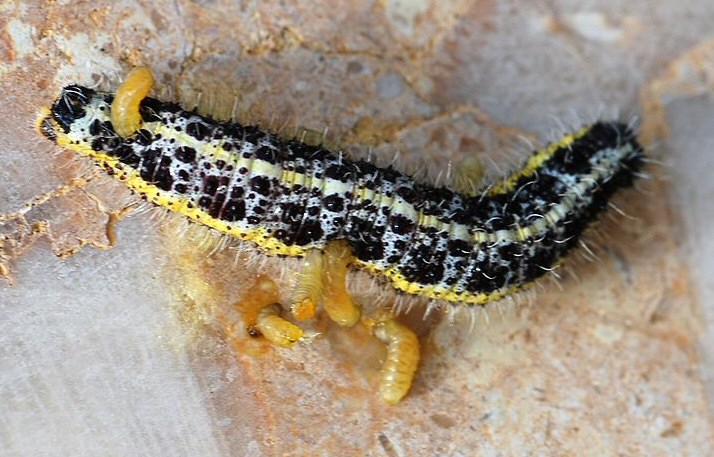
![Photo: S. Rae from Scotland, UK [CC BY 2.0 (https://creativecommons.org/licenses/by/2.0)], via Wikimedia Commons](images/800px-Dinocampus_coccinellae_pupa_-_Flickr_-_S._Rae.jpg)
The ladybird parasitoid, Dinocampus coccinellae, inserts an egg into the underside of an adult ladybird’s body. Several ladybird species can be attacked but 7-spot ladybird is the most frequent host. The parasitoid larva develops inside the ladybird’s abdomen. When it is fully fed it paralyses the ladybird by destroying its nervous system. It emerges from the host insect and spins a silk cocoon in which it pupates underneath the ladybird’s body. The red and black markings on a ladybird are warning colouration that tell birds and other predators that ladybirds are not good to eat. By hiding itself under the immobilised ladybird’s body, the parasitoid pupa benefits from this protection.
Role of parasitic wasps in gardens
Parasitic wasps, along with other parasitic and predatory insects, play an important part in helping to limit population numbers of insects and spiders. Some parasitic wasps are reared by companies dealing in biological controls and can be purchased for use in gardens, especially against some glasshouse pests. Encarsia formosa is used against glasshouse whitefly nymphs; Anagrus atomus is used against eggs of glasshouse leafhopper; Aphidius colemani, Aphidius ervi and Praon species against aphid nymphs; Dacnusa sibirica against larvae of the chrysanthemum leaf miner; Leptomastix species against mealybug nymphs; Metaphycus helvolus against soft scale nymphs.
References:
1. Owen, J.,Townes, H. and Towns, M. (1981) Species diversity of Ichneumonidae and Serphidae (Hymenoptera) in an English suburban garden. Biological Journal of the Linnean Society, 16:315–336. https://doi.org/10.1111/j.1095-8312.1981.tb01656.x
2. Owen, J. (1991) The ecology of a garden: the first fifteen years. Cambridge University Press
Other sources of information
Books
Gauld, I. & Bolton, B. (editors) (1988) The Hymenoptera. Oxford University Press
Fergusson, N. D.M. (1986) Handbooks for the Identification of British Insects Vol 8 part 1c. Charipidae, Ibaliidae and
Figitidae Hymenoptera - Cynipoidea. Royal Entomological Society
Askew, R. R. (1968) Handbooks for the Identification of British Insects Vol 8 part 2b. Hymenoptera – Chalcidoidea
section a
Ferriere, Ch. & Kerrich, G. J. (1958) Handbooks for the Identification of British Insects Vol 8 part 2a. Hymenoptera –
Chalcidoidea Section a
Fitton, M. G., Shaw, R. T. & Gauld, I. D. (1998) Handbooks for the Identification of British Insects Vol 7 part 1.
Pimpline ichneumon-flies Hymenoptera – Ichneumonoidea (Pimplinae)
Gauld, I. D. & Mitchell, P. A. (1977) Handbooks for the Identification of British Insects Vol 7 part 2b. Ichneumonidae
– Orthopelmatinae, and Anomaloninae
Helyer, N., Brown, K. & Cattlin, N. D. (2003) A colour handbook of biological control in plant protection. Manson
Publishing
Nixon, G. E. J, (1957) Handbooks for the Identification of British Insects Vol 8 part 3dii. Hymenoptera –
Proctotrupoidea Diapriidae subfamily Belytinae
Nixon, G. E. J, (1980) Handbooks for the Identification of British Insects Vol 8 part 3di. Diapriidae (Diapriinae)
Hymenoptera – Proctotrupoidea
Perkins, J. F. (1959) Handbooks for the Identification of British Insects Vol 7 part 2ai. Hymenoptera –
Ichneumonoidea
Perkins, J. F. (1960) Handbooks for the Identification of British Insects Vol 7 part 2aii. Hymenoptera –
Ichneumonoidea
Quinlan, J. (1978) Handbooks for the Identification of British Insects Vol 8 part 1b. Hymenoptera – Cynipoidea:
Eucoilidae
Shaw, M. R. & Huddleston, T. (1991 Handbooks for the Identification of British Insects Vol 7 part 11. Classification
and biology of braconid wasps (Hymenoptera: Braconidae)
The above handbooks are out of print, but available as free dowloads from here
By Andrew Halstead reviewed by Andrew Salisbury edited by Steve Head
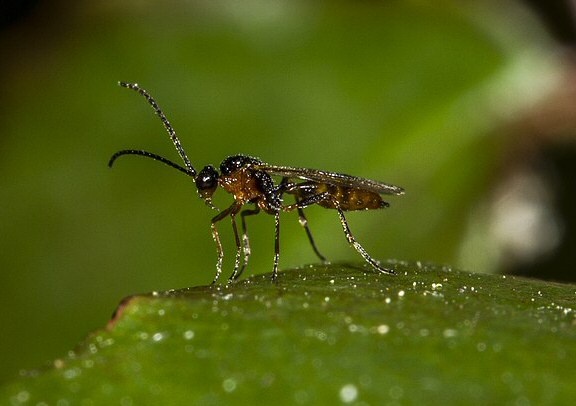
![Photo: gailhampshire from Cradley, Malvern, U.K [CC BY 2.0 (https://creativecommons.org/licenses/by/2.0)], via Wikimedia Commons](images/Netelia_species_-_Flickr_-_gailhampshire_(2).jpg)
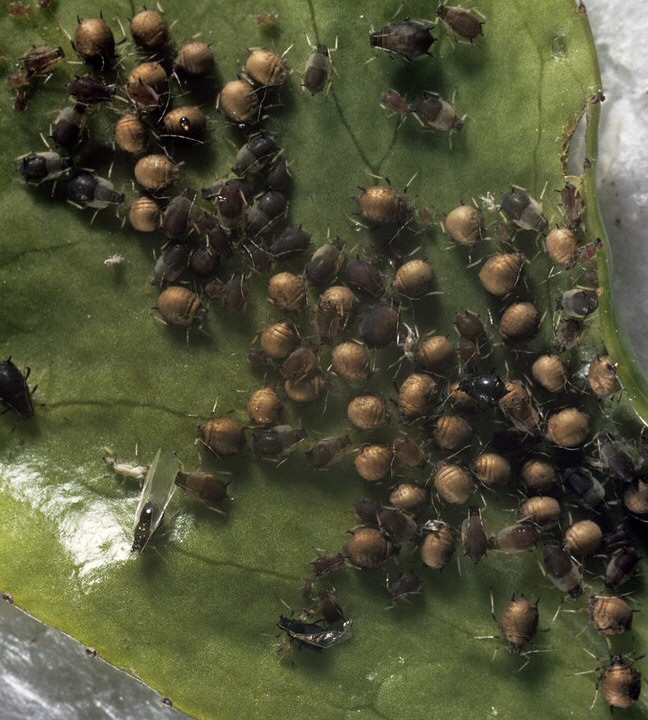
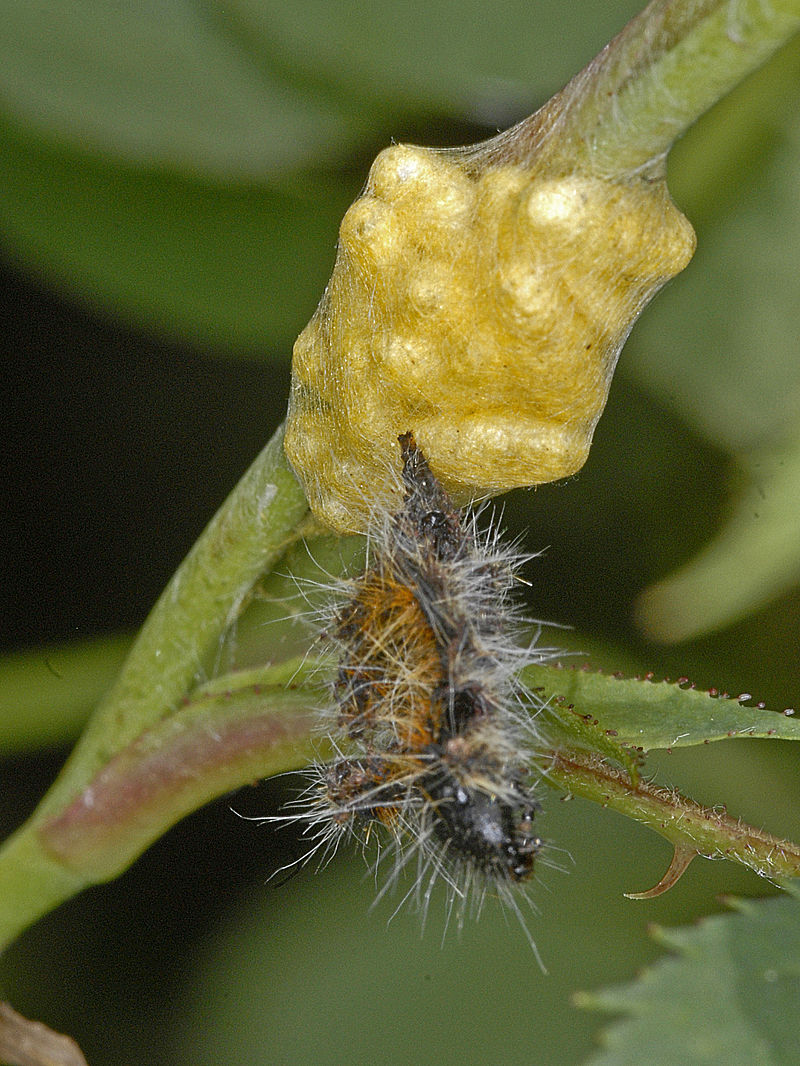
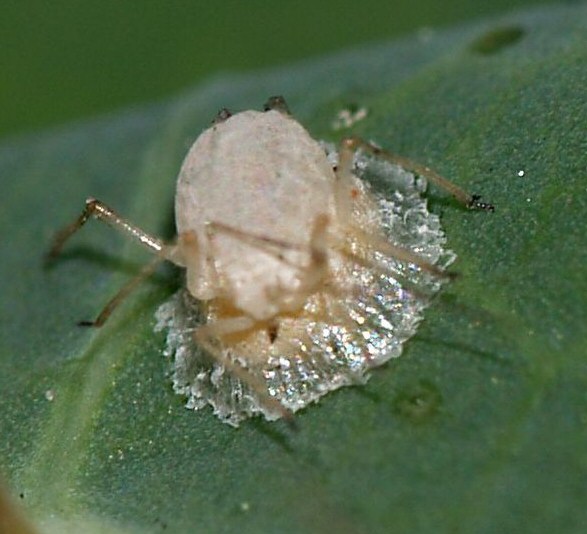
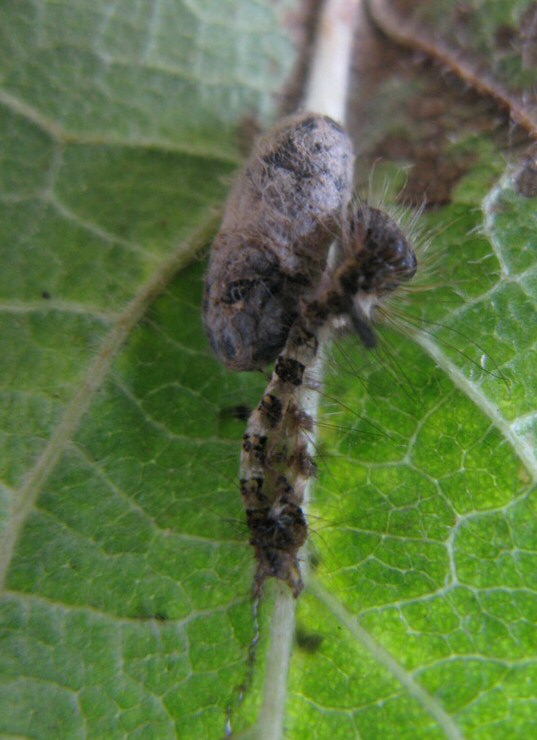
Above left: A group of aphids where most are parasitized by the chalcid wasp Lysiphlebus fabarum. The host aphids are very bloated and almost spherical compared with the normal insects. There are a couple of adult wasps visible. Centre and right: the braconid parasitoid Cotesia glomerata, larvae emerging from a dying Large white butterfly caterpillar, and then the cocoons wrapped in silk with the dried caterpillar skin underneath .
Below left: Aphid parasitized by the braconid Praon sp., the wasp cocoon is under the aphid. Centre: cocoon of an unidentified parasitic wasp by the dried remains of its host, a caterpillar of the grey dagger moth Acronicta psi. Right:
dead 7-spot ladybird parasitised by the braconid Dinocampus coccinellae, the pupa in its cocoon is beneath the host.
Parasitic wasps
More than 80% of the 7,761 species of Hymenoptera in the British Isles develop as parasitoids on, or inside the various life stages of insects and some other arthropods, such as spiders. Anyone who collects moth or butterfly caterpillars and tries to rear them to the adult stage is likely to find that some produce adult parasitic wasps, rather than the expected moth or butterfly.
There are upwards of 40 families of parasitoid wasps known, nearly all within the sub-order Apocrita or "wasp-waist". Important families in the UK and Ireland include the large groups of Ichneumonidae, the Braconidae and the Chalcidoidea. Jennifer Owen recorded an astonishing 529 species of ichneumonids1, mostly caught in her malaise trap, although only 29 species caught in 1972-73 are named in her popular book. Many of the 529 were new records for Britain, and 4 previously unknown to science2 . Owen was unable to get Braconids and Chalcids identified so these were not recorded.
Parasitic wasps are mostly very small, and with the colossal number of species recorded, adults as well as larvae are very hard to identify reliably. Generally people are more familiar with them when spotted on dead hosts, or as biological controls. Nevertheless, more data on these creatures in gardens would be very helpful, especially for the abundant Braconids and Chalcids.
Species in Britain and Ireland
More than 6,500 species of parasitic wasp have been recorded in Britain and Ireland, and it is likely than there are more waiting to be discovered. Some common species likely to be seen in gardens are the braconid parasitoid Cotesia glomerata (until recently Apanteles glomeratus), which develops as larvae in caterpillars of the Large white butterfly; Dinocampus coccinellae, which develops as a larva inside adult 7-spot ladybirds; various Aphidius, Praon and Aphelinus species that develop as larvae inside aphids.

![Photo: gailhampshire from Cradley, Malvern, U.K [CC BY 2.0 (https://creativecommons.org/licenses/by/2.0)], via Wikimedia Commons](images/Netelia_species_-_Flickr_-_gailhampshire_(2).jpg)
Above left: Braconid wasp Aphidius ervi, which is used in some countries as an aphid biocontrol in greenhouses. Right: Species of the ichneumon wasp Netelia, Jennifer Owen recorded Netelia inedita in her book.
Biology
Parasitic wasps vary considerably in size and this is partly related to that of the host. Some develop inside insect eggs and have adults that are less that 1mm in length. Others develop inside large caterpillars and can be up to 30mm long. Some female parasitic wasps have what appears to be a long ‘sting’ on the rear end of the abdomen. This is part of the female’s egg-laying equipment. Those with particularly long ‘stings’ are likely to be parasitoids of insect larvae that feed in concealed locations, such as stem borers. These parasitic wasps need long ovipositors to drill down to where the host insect is feeding in order to deposit one or more eggs.
Insects can be attacked by parasitic wasps at any stage in their life cycle, such as at the egg stage, larvae or nymphs at various ages, pupae or adults. The larval and nymphal stages are targeted by the greatest number of parasitic wasp species, with the adult stage having the fewest parasitic species. Most parasitoids develop as larvae inside their host animals and are known as endoparasites. Some feed externally on their hosts, particularly the larvae of some parasitic wasps associated with caterpillars and spiders. These are known as ectoparasites.
Parasitic wasps can themselves be the target of other species of parasitic wasps. The parasitoid of another parasitoid is called a hyperparasite.
Life cycle
Parasitic wasps lay their eggs either on the outside of the host animal or they insert the eggs inside. Multiple eggs may be laid in or on large host animals, or eggs are laid singly in small insects, such as aphids, or in insect eggs. On hatching, the parasitoid larvae initially absorb nutrients from fluids in the host insect or spiders’ bodies. Later they feed on non-vital organs, such as fat reserves. The host animal continues feeding and shows no signs of distress until the parasitoid larva or larvae have reached the stage where they are fully fed. In the case of parasitoids developing in caterpillars, this often coincides with the host caterpillar also completing its feeding. At that stage, the parasitoid larvae complete their feeding by eating the host animal’s internal organs. The parasitoids either pupate within the carcass of their dead host, or they emerge and pupate in silk cocoons nearby.
Aphids that have been parasitized develop abnormally swollen and rounded bodies compared to healthy aphids. When a parasitized aphid has died, it becomes greyish brown. Pupation of the parasitoid takes place within the dead aphid. The adult wasp emerges through a circular hole eaten in the upper surface of the aphid.



Above left and right: the braconid parasitoid Cotesia glomerata, larvae emerging from a dying Large white butterfly caterpillar, and then the cocoons wrapped in silk with the dried caterpillar skin underneath.
Left: A group of aphids where most are parasitized by the chalcid wasp Lysiphlebus fabarum. The host aphids are very bloated and almost spherical compared with the normal insects. There are a couple of adult wasps visible.
Above left: Aphid parasitized by the Braconid Praon sp., the wasp cocoon is under the aphid. Right: cocoon of an unidentified parasitic wasp by the dried remains of its host, a caterpillar of the Grey dagger moth Acronicta psi.
Left: dead 7-spot ladybird parasitised by the braconid Dinocampus coccinellae, the pupa in its cocoon is beneath the host.


The ladybird parasitoid, Dinocampus coccinellae, inserts an egg into the underside of an adult ladybird’s body. Several ladybird species can be attacked but 7-spot ladybird is the most frequent host. The parasitoid larva develops inside the ladybird’s abdomen. When it is fully fed it paralyses the ladybird by destroying its nervous system. It emerges from the host insect and spins a silk cocoon in which it pupates underneath the ladybird’s body. The red and black markings on a ladybird are warning coloration that tell birds and other predators that ladybirds are not good to eat. By hiding itself under the immobilised ladybird’s body, the parasitoid pupa benefits from this protection.
Role of parasitic wasps in gardens
Parasitic wasps, along with other parasitic and predatory insects, play an important part in helping to limit population numbers of insects and spiders. Some parasitic wasps are reared by companies dealing in biological controls and can be purchased for use in gardens, especially against some glasshouse pests. Encarsia formosa is used against glasshouse whitefly nymphs; Anagrus atomus is used against eggs of glasshouse leafhopper; Aphidius colemani, Aphidius ervi and Praon species against aphid nymphs; Dacnusa sibirica against larvae of the chrysanthemum leaf miner; Leptomastix species against mealybug nymphs; Metaphycus helvolus against soft scale nymphs.
References:
1 Owen, J.,Townes, H. and Towns, M. (1981) Species diversity of Ichneumonidae and Serphidae (Hymenoptera) in an English suburban garden. Biological Journal of the Linnean Society, 16:315–336. https://doi.org/10.1111/j.1095-8312.1981.tb01656.x
2 Owen, J. (1991) The ecology of a garden: the first fifteen years. Cambridge University Press
Other sources of information
Books
Gauld, I. & Bolton, B. (editors) (1988) The Hymenoptera. Oxford University Press
Fergusson, N. D.M. (1986) Handbooks for the Identification of British Insects Vol 8 part 1c. Charipidae, Ibaliidae and
Figitidae Hymenoptera - Cynipoidea. Royal Entomological Society
Askew, R. R. (1968) Handbooks for the Identification of British Insects Vol 8 part 2b. Hymenoptera – Chalcidoidea
section a
Ferriere, Ch. & Kerrich, G. J. (1958) Handbooks for the Identification of British Insects Vol 8 part 2a. Hymenoptera –
Chalcidoidea Section a
Fitton, M. G., Shaw, R. T. & Gauld, I. D. (1998) Handbooks for the Identification of British Insects Vol 7 part 1.
Pimpline ichneumon-flies Hymenoptera – Ichneumonoidea (Pimplinae)
Gauld, I. D. & Mitchell, P. A. (1977) Handbooks for the Identification of British Insects Vol 7 part 2b. Ichneumonidae
– Orthopelmatinae, and Anomaloninae
Helyer, N., Brown, K. & Cattlin, N. D. (2003) A colour handbook of biological control in plant protection. Manson
Publishing
Nixon, G. E. J, (1957) Handbooks for the Identification of British Insects Vol 8 part 3dii. Hymenoptera –
Proctotrupoidea Diapriidae subfamily Belytinae
Nixon, G. E. J, (1980) Handbooks for the Identification of British Insects Vol 8 part 3di. Diapriidae (Diapriinae)
Hymenoptera – Proctotrupoidea
Perkins, J. F. (1959) Handbooks for the Identification of British Insects Vol 7 part 2ai. Hymenoptera –
Ichneumonoidea
Perkins, J. F. (1960) Handbooks for the Identification of British Insects Vol 7 part 2aii. Hymenoptera –
Ichneumonoidea
Quinlan, J. (1978) Handbooks for the Identification of British Insects Vol 8 part 1b. Hymenoptera – Cynipoidea:
Eucoilidae
Shaw, M. R. & Huddleston, T. (1991 Handbooks for the Identification of British Insects Vol 7 part 11. Classification
and biology of braconid wasps (Hymenoptera: Braconidae)
The above handbooks are out of print, but available as free dowloads from here
By Andrew Halstead reviewed by Andrew Salisbury edited by Steve Head
![Photo: S. Rae from Scotland, UK [CC BY 2.0 (https://creativecommons.org/licenses/by/2.0)], via Wikimedia Commons](images/800px-Dinocampus_coccinellae_pupa_-_Flickr_-_S._Rae.jpg)












